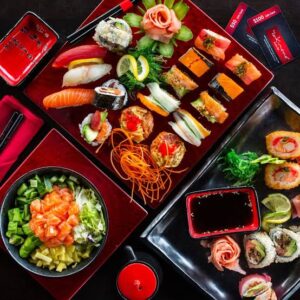Introduction to Yakimono Menu, a term in Japanese cuisine, refers broadly to dishes that are grilled or broiled. This cooking style is beloved for its ability to enhance the natural flavors of ingredients, ranging from fish and meat to vegetables. The direct heat imparts a smoky flavor and a delightful char that is uniquely satisfying. In this exploration of the Yakimono menu, we will delve into the various dishes that make up this delicious segment of Japanese cuisine, uncovering both traditional favorites and modern twists.
Traditional Yakimono Menu Dishes
Yakitori (Grilled Chicken Skewers): Perhaps the most famous of all yakimono, yakitori is made from chicken cut into small pieces, skewered, and grilled over charcoal. It’s commonly flavored with salt or tare, a sweet soy sauce-based marinade.
Saba Shioyaki (Grilled Mackerel): This simple yet flavorful dish features mackerel seasoned with salt and grilled until the skin is crisp. Saba shioyaki is a staple in Japanese home cooking, appreciated for its rich, oily texture and robust flavor.
Seafood Specialties
Hamachi Kama (Yellowtail Collar): Considered a delicacy, the collar of yellowtail fish is seasoned and grilled to perfection. The meat near the fish’s collar is especially tender and flavorful, making it a sought-after dish at Japanese restaurants.
Unagi Kabayaki (Grilled Eel): Unagi, or freshwater eel, is filleted, skewered, and dipped in a thick, sweet soy-based sauce before being grilled. The result is a caramelized exterior with a soft, flaky interior.
Meat Variations

Gyu-Kushi (Beef Skewers): Skewered chunks of beef are seasoned with salt or a variety of sauces and grilled. These skewers can be made from different cuts of beef, offering a range of textures and flavors.
Buta no Kakuni (Braised Pork Belly): While primarily braised, this pork belly dish is often finished on the grill to add a smoky flavor that complements its rich, melt-in-your-mouth texture.
Vegetarian Options

Nasu Dengaku (Miso Glazed Eggplant): Thick slices of eggplant are grilled and then brushed with a sweet and savory miso glaze. This dish is a popular vegetarian option that showcases the grill’s ability to enhance the sweetness of vegetables.
Shiitake Yakimono (Grilled Shiitake Mushrooms): Large shiitake mushrooms are seasoned and grilled until they develop a meaty texture and deep, umami flavor.
Modern Takes on Yakimono
Cheese Maki (Grilled Cheese Rolls): A modern yakimono dish where cheese is wrapped in thin slices of meat or vegetables before being grilled. These rolls offer a delightful contrast between the crisp exterior and gooey, melted interior.
Fusion Yakitori: Contemporary chefs are experimenting with ingredients like lamb, duck, and even vegetarian mock meats, expanding the traditional yakitori repertoire to suit modern palates and dietary preferences.
Pairings and Accompaniments A typical yakimono meal might be accompanied by a bowl of steamed rice, miso soup, and a selection of pickled vegetables. These sides complement the grilled flavors and provide a balanced meal. For beverages, cold beer or sake typically pairs well, enhancing the overall dining experience.
The Allure of Yakimono Menu is not just a cooking technique; it’s a reflection of the Japanese ethos of simplicity and respect for ingredients. Whether you’re enjoying a simple skewer of grilled chicken or a more elaborate grilled seafood dish, the yakimono menu offers a rich tapestry of flavors that are deeply connected to Japanese culture and culinary traditions. The next time you dine at a Japanese restaurant, consider diving into the diverse offerings of the yakimono menu to truly understand the charm and depth of this beloved style of cooking.
Exploring Yakimono Varieties: A Deeper Dive into Grilled Cuisine
Seasonal Yakimono Delights
Ayame Shio (Salt-Grilled Sweetfish): During the summer months, sweetfish (ayu) is a popular choice for yakimono. This small river fish is grilled whole with a sprinkle of salt to bring out its delicate flavor. It’s particularly enjoyed during the ayu fishing season, which coincides with traditional Japanese festivals.
Sanma (Pacific Saury): In autumn, sanma becomes a centerpiece in many Japanese meals. This oily fish is salted and grilled whole, often served with a side of grated daikon radish and a squeeze of sudachi lime, reflecting the seasonal focus of Japanese cuisine.
Regional Yakimono Specialties
Hokkaido Kinki Fish: In the colder regions of Hokkaido, kinki fish, also known as thornyhead, is a prized ingredient for yakimono. Its high fat content makes it perfect for grilling, resulting in a juicy, flavorful dish that is a winter favorite.
Kyushu’s Satsuma-age: Although primarily known as a fried dish, some variations of Satsuma-age from Kyushu are finished on the grill to add a smoky flavor to the fried fish cakes, blending different cooking techniques for a unique taste.
Innovative Grilling Techniques
Binchotan Charcoal Grilling: This high-quality charcoal is prized for its ability to grill at a steady, high heat while producing minimal smoke. This allows the natural flavors of the food to shine through, making it the charcoal of choice for many yakimono chefs.
Irori Grilling: An irori is a traditional Japanese sunken hearth used in ancient times for heating and cooking. Grilling yakimono over an irori not only imparts a unique flavor but also provides a nostalgic dining experience.
Yakimono in Contemporary Japanese Culture
Kaiseki Cuisine: Yakimono dishes are often included in Kaiseki, a traditional multi-course Japanese meal. Each dish is carefully prepared to highlight seasonal ingredients and demonstrate the chef’s technique.
Street Food and Festivals: Yakimono is also a staple at Japanese festivals and street food markets. Items like yakitori and grilled squid are popular among attendees looking for a quick and delicious snack.
Health Benefits of Yakimono
Low-Fat Cooking Method: Grilling is a healthier cooking method that reduces fat content while retaining nutrients, making yakimono a favorite among health-conscious diners.
Rich in Omega-3 Fatty Acids: Many of the fish used in yakimono, like mackerel and salmon, are high in omega-3 fatty acids, which are beneficial for heart health.
DIY Yakimono: Grilling at Home
Equipment Essentials: To enjoy yakimono at home, invest in a small tabletop grill or a yakitori grill. Charcoal, preferably binchotan, is recommended for the most authentic flavor.
Marinades and Sauces: Experiment with different marinades such as soy sauce, mirin, sake, and ginger to add variety to your grilled dishes. Homemade tare sauce can be a delightful addition to your yakitori.
Conclusion: Embracing the Yakimono Menu Tradition Whether dining out or grilling at home, the diverse range of yakimono offers something for everyone, from seafood lovers to vegetarian diners. By embracing both traditional and innovative grilling methods, yakimono remains a beloved tradition in Japanese cuisine that continues to evolve while staying rooted in its cultural heritage. As you explore these grilled delights, you not only satisfy your palate but also partake in a rich culinary tradition that is integral to Japanese culture.


